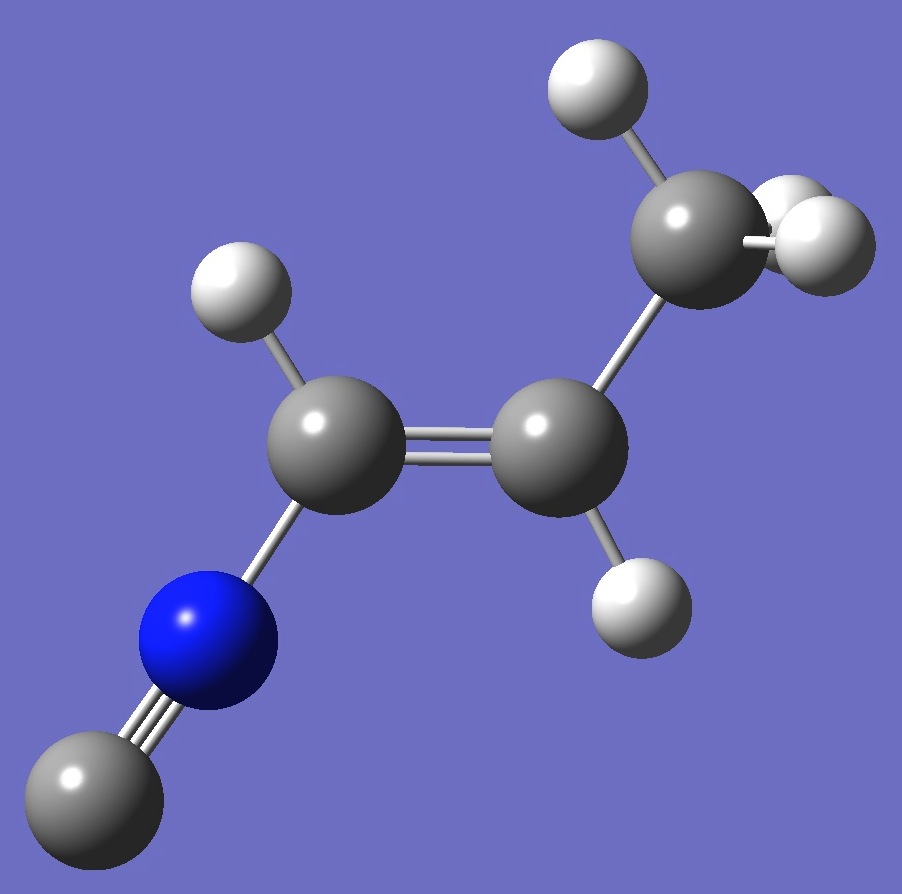

| |
|||||||
| Table 1. Nitrogen nqcc's in Z-Propenylisocyanide (MHz). Calculation was made
on CCSD/cc-pVTZ ropt structure of Samdal et al. |
|||||||
| |
|||||||
| Calc |
Expt |
||||||
| |
|||||||
| 14N | Xaa | - |
0.015 |
||||
| Xbb | - |
0.049 |
|||||
| Xcc | 0.064 |
||||||
| |Xab| | 0.383 |
||||||
| RSD |
0.030 (1.3 %) |
||||||
| Xxx | - |
0.416 |
|||||
| Xyy | 0.064 |
||||||
| Xzz | 0.352 |
||||||
| ETA |
- |
1.364 |
|||||
| Øz,a |
43.73 |
||||||
| Øa,NC | 37.70 |
||||||
| Øz,NC | 6.04 |
||||||
| |
|||||||
| |
|||||||
| Table 2. Nitrogen nqcc's in E-Propenylisocyanide (MHz). Calculation was made
on CCSD/cc-pVTZ ropt structure of Samdal et al. |
|||||||
| |
|||||||
| Calc |
Expt |
||||||
| |
|||||||
| 14N | Xaa | 0.269 |
|||||
| Xbb | - |
0.311 |
|||||
| Xcc | 0.042 |
||||||
| |Xab| | 0.313 |
||||||
| RSD |
0.030 (1.3 %) |
||||||
| Xxx | - |
0.449 |
|||||
| Xyy | 0.042 |
||||||
| Xzz | 0.406 |
||||||
| ETA |
- |
1.209 |
|||||
| Øz,a |
23.55 |
||||||
| Øa,NC | 14.47 |
||||||
| Øz,NC | 9.08 |
||||||
| |
|||||||
| Table 3. Propenylisocyanide CCSD/cc-pVTZ optimized structure parameters (Å and degrees). | |||||
| |
|
||||
| |
|||||
| # B3PW91/6-311+G(df,pd) prop scf=tight Propenylisocyanide 0 1 C C 1 B1 H 1 B2 2 A1 H 2 B3 1 A2 3 D1 C 2 B4 1 A3 3 D2 H 5 B5 2 A4 1 D3 H 5 B6 2 A5 1 D4 H 5 B7 2 A6 1 D5 N 1 B8 2 A7 5 D6 C 9 B9 1 A8 2 D7 |
|||||
| Z-Propenylisocyanide | E-Propenylisocyanide | ||||
| B1 1.333 B2 1.087 B3 1.082 B4 1.495 B5 1.088 B6 1.091 B7 1.091 B8 1.390 B9 1.172 A1 122.7 A2 116.2 A3 126.0 A4 111.6 A5 110.3 A6 110.3 A7 122.8 A8 178.4 D1 0.0 D2 180.0 D3 0.0 D4 120.9 D5 -120.9 D6 0.0 D7 180.0 |
B1 1.332 B2 1.080 B3 1.083 B4 1.496 B5 1.089 B6 1.091 B7 1.091 B8 1.389 B9 1.172 A1 123.0 A2 118.5 A3 123.3 A4 111.4 A5 110.6 A6 110.6 A7 122.4 A8 177.8 D1 180.0 D2 0.0 D3 0.0 D4 120.9 D5 -120.9 D6 180.0 D7 180.0 |
||||
| Table 4. Propenylisocyanide Quartic Centrifugal Distortion Constants (kHz). Calc = B3LYP/cc-pVTZ | ||||||||
| ____Z-Propenylisocyanide_____ | ____E-Propenylisocyanide_____ | |||||||
| Calc |
Expt [1] |
Calc |
Expt [1] | |||||
| Delta_J |
2.67 |
3.137(12) |
0.268 |
0.3062(12) |
||||
| Delta_JK | - |
21.1 |
- |
22.462(29) |
- |
14.7 |
- |
16.322(34) |
| Delta_K | 86.8 |
82.81(35) |
893. |
|||||
| delta_J | 0.862 |
1.0272(16) |
0.0272 |
|||||
| delta_K | 4.68 |
5.311(44) |
- |
0.380 |
||||